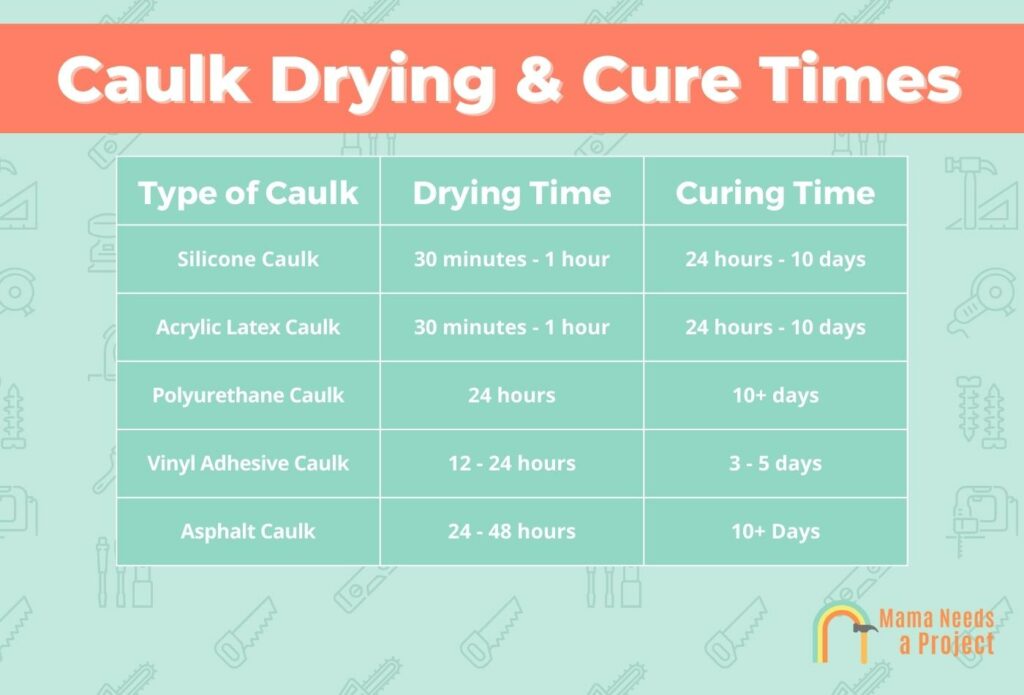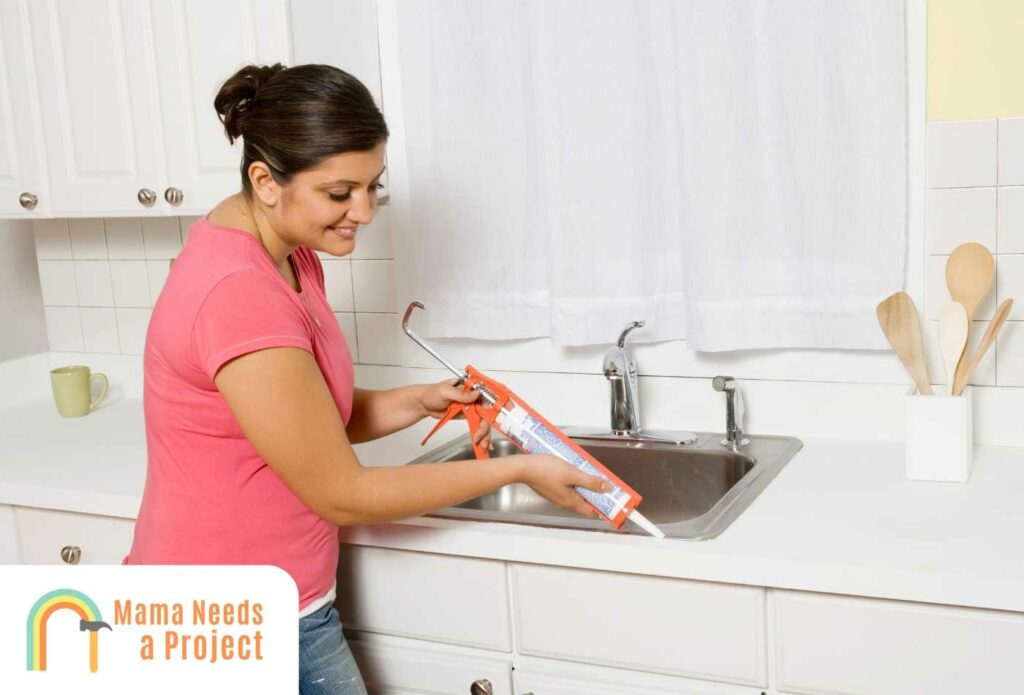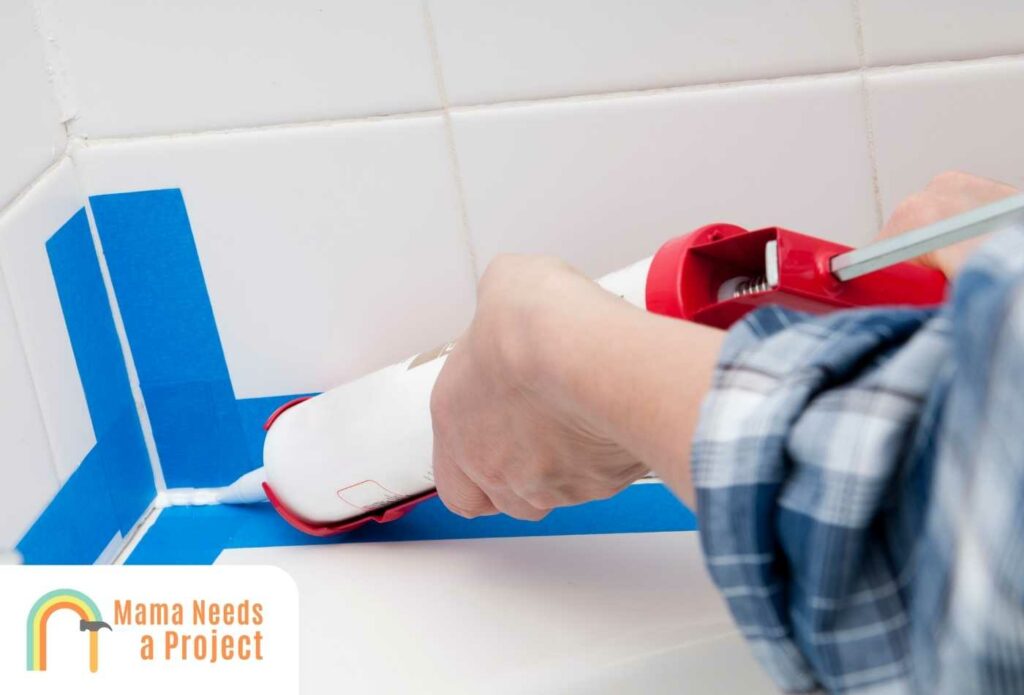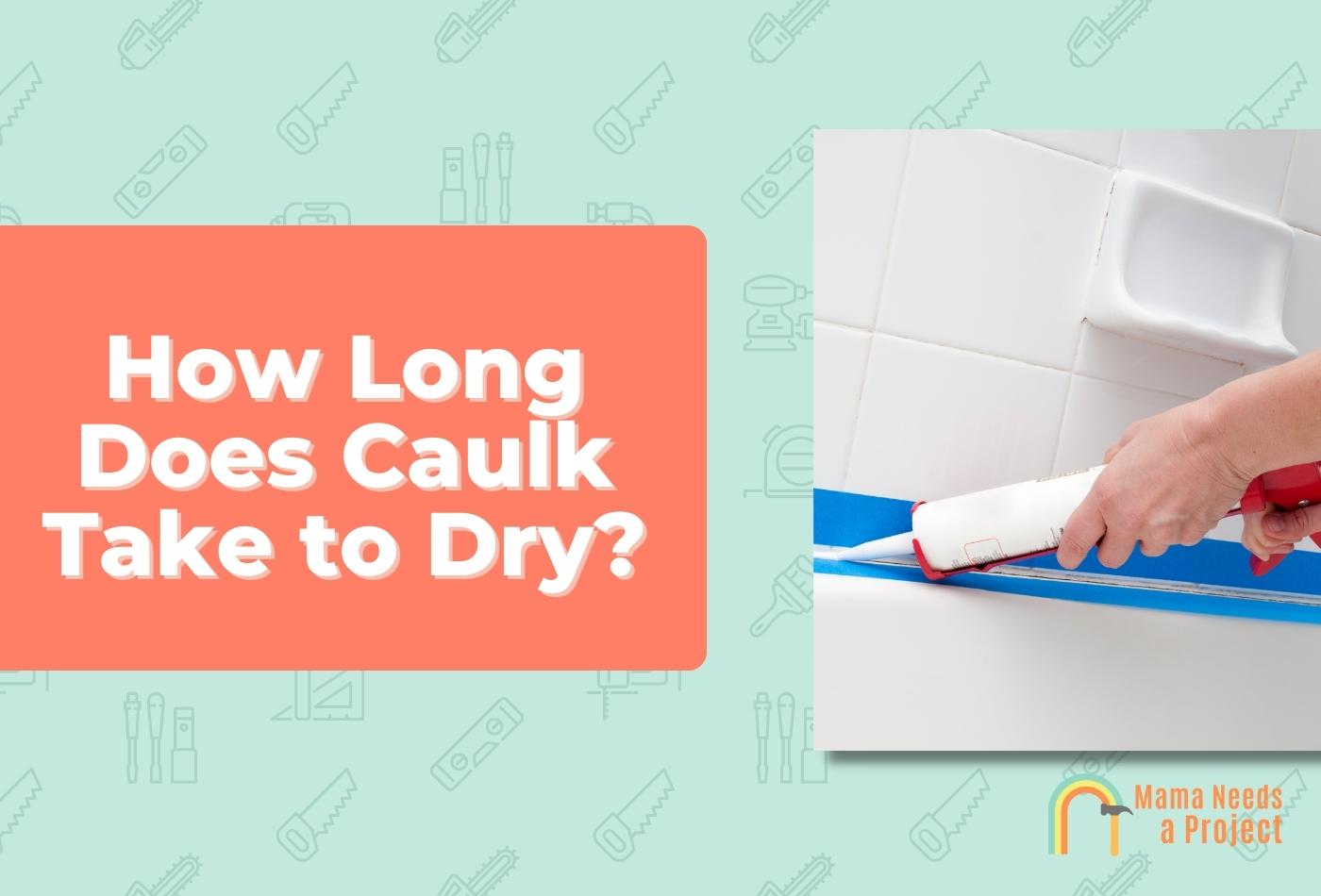How Long Does Caulk Take to Dry? (Simple Answer by Type)
Caulk is a tremendous waterproof sealant that has many residential applications, especially in bathrooms and kitchens.
But people frequently ask when applying this sealant is: “How long does caulk take to dry?”
And for good reason! If you don’t wait for caulk to dry before it gets wet, it could void the waterproof seal you’re looking for in the first place.
In this article, I’ll explore the drying times and curing times for different types of caulk and how you can speed up the process. Let’s dig in!

Difference Between Dry and Cured Caulk
Before I answer the main question, I need to point out the difference between “dry” and “cured” when it comes to caulk.
Although many people use these terms interchangeably, the truth is that dry caulk isn’t the same as cured caulk, and failure to recognize this distinction could cause you to apply caulk improperly.
When caulk is “dry”, it won’t feel moist when you touch it. But just because the caulk feels this way doesn’t mean it’s dry all the way through, or cured.
When it comes to silicone caulk, the outermost layer will often feel dry 30 minutes to an hour after application. It’ll feel this way because of exposure to oxygen. But it’ll take far longer for all the caulk to solidify and create an effective seal.
If you’re planning to sand caulk, you need to be sure it has fully cured before starting.
How Long Does Silicone Caulk Take to Dry?
Silicone caulk dries about 30 minutes to an hour after it’s applied. If, however, you’re using a high-grade caulk, you can expect this caulk to dry in 3 to 12 hours.
If you’re applying silicone caulk to an area that’s constantly coming into contact with moisture, it may take longer for the caulk to dry and cure.
Working on a wood project? Check out these wood drying times!
How Long Does It Take Non-Silicone Caulks to Dry?
Silicone caulk isn’t the only kind of caulk on the market. In fact, there are a handful of popular caulks, and some dry quicker than others. Consult the list below to know which caulks dry fastest:
Silicone Caulk: 30 min to 1 hour
Acrylic Latex Caulk: 30 min to 1 hour
Polyurethane-Based Caulk: 24 hours
Vinyl Adhesive Caulk: 24 hours
Asphalt Caulk: 1 to 2 days
How Long Does It Take Caulk to Cure?
Silicone
It usually takes 3 to 12 hours for silicone caulk to dry, but it will take around 24 hours to fully cure.
A variety of factors collectively determine how long it takes silicone caulk to cure, including humidity, temperature, the type of silicone being used, and the purity of the silicone.
Humidity: Caulk cures faster in a humid environment because humidity facilitates the chemical reactions that occur when caulk is exposed to oxygen.
Temperature: If getting caulk to cure quickly is your goal, you should make sure the area where the caulk is curing is between 40°F and 80°F.
However, you should refrain from doing anything to directly heat the caulk—like blowing on it with a hairdryer—as doing so can actually cause the caulk to cure improperly.
Type of Silicone: If you’re using a high-grade silicone caulk, like one that can handle high heat or expand while being dispensed, expect the curing process to take around 30 to 36 hours.
Special silicone caulks take longer to cure in large part because they have complex chemical makeups.
Purity of Silicone: Silicone caulk that includes acrylic or elastomeric compounds can also take longer to cure. These caulks are usually used indoors.
Acrylic Latex Caulk
It usually takes multiple days for acrylic latex caulk to cure completely. In most cases, it will require 48 hours to up to 10 days for this caulk to become fully cured.
Acrylic latex caulk must be applied to a dry surface to ensure an effective seal, to it’s not a good idea for locations exposed to moisture often. (In other words, it’s not good in bathrooms, around kitchen sinks, or outdoors.
Polyurethane Caulk
Polyurethane caulk holds up well against the elements, which is why it’s often used as a sealant outdoors or in areas where moisture exposure is frequent. Polyurethane caulk can take over a week to dry and cure effectively. While the drying time is typically around 24 hours, it takes much longer to cure.
Note: Applying this caulk to a moist surface will elongate both the drying and curing processes.
Vinyl Adhesive Caulk
Unlike the other caulks discussed so far, vinyl adhesive caulk is actually inhibited by humidity, which means if you apply it in an area where there’s high humidity, it’ll take longer to cure and probably cure improperly.
Vinyl adhesive caulk dries in 12 to 24 hours, and it takes three to five days for this kind of caulk to cure completely.
You can use fans to expedite the drying and curing processes, but it’s best to refrain from using a hair dryer or other hot-air-blowing machines.
Asphalt Caulk
This caulk is exclusively used to seal asphalt surfaces, and it can be longer than 10 days before this caulk is completely cured.
Asphalt caulk is usually dry two to three days after it’s applied, provided there’s no adverse weather immediately after application.
If, for example, asphalt caulk is applied and it rains soon after, it may take longer for the asphalt caulk to dry and cure.
Note: Unless you’re using a special caulk that can cure while covered with paint, you should wait until the caulk is completely cured before you paint it. If you don’t wait, you run the risk of mixing the paint and caulk, which will lead to an unsightly result.
Factors That Determine Drying Time
Type of Caulk & Formula
There are a handful of types of caulk you can choose from, and some dry faster than others.
For example, silicone caulk usually takes 30 minutes to an hour to dry—provided it’s applied in a space where temperature and humidity are both ideal—whereas polyurethane-based caulk can dry in about 24 hours.
Even though some silicone caulks are marketed to be a fast drying caulk, it’s best to give these sealants 3 to 12 hours of drying time before working with them—just to be on the safe side.
There are also caulks that can cure beneath paint, and these are usually dried and paintable after just 30 minutes. Compare such caulk to polyurethane caulk, which sometimes takes as long as 10 days to fully cure and become paint-ready.
No matter what kind of caulk you use, it’s best to follow the manufacturer’s instructions and caulking process so you can ensure the best possible application.
Humidity
Humidity plays a big role in the caulk drying and curing processes. And while some caulks need moisture to cure properly, others should be kept from moisture so it doesn’t inhibit the curing process.
Specifically, silicone caulk needs moisture to cure, which is why it’s best to have a humidifier nearby after you apply this sealant if you live in a dry climate.
On the other hand, if you’re applying acrylic latex caulk, you’ll need a fan nearby to dissipate the moisture that’s released as the sealant cures.
Polyurethane-based caulk should be kept from moisture for at least three days, but it may take up to a week for this caulk to be able to handle moisture exposure.
Pay attention to the humidity of the room you’re applying caulk in.
Temperature
The temperature in the area where you’re applying caulk should never go beyond the range of 40°F to 80°F.
For this reason, while you’re waiting for the caulk to cure, you should regularly check the thermostat to ensure you don’t expose it to extreme cold or warm temperatures.
Keep in mind that if you’re applying caulk in the winter, you’ll need to wait longer for the caulk to cure completely, mainly because there won’t be a lot of moisture in the air.
If you find yourself in this situation, you should refrain from cranking up the heat or using a hairdryer directly on the caulk, as either action could melt the caulk and cause it to cure improperly.
Acrylic latex caulk, on the other hand, may freeze before it has a chance to cure completely, which is why it’s best to avoid using this caulk in freezing temperatures
Freshness
Expired caulk or caulk that has been exposed to the elements for too long will likely have difficulty curing.
If you end up using old or defective caulk, it’s likely you’ll find that such caulk can’t cure properly.
Check the expiration date on the tube before you start using caulk. If you can’t find an expiration date, play things safe and open up a new tube.
Fresh caulk should develop a “skin”, i.e. a dry outer layer, about 30 minutes after it’s applied.
Silicone, polyurethane, and acrylic latex caulks can last for years, but they’re best the year they’re manufactured.
Check out this guide to learn how to paint over silicone caulking!

How to Tell if Caulk Is Dry
The easiest way to tell whether or not caulk is dry is to touch it with the tip of your finger. If the outer layer feels dry but also feels like just a little bit of pressure could cause an indent, this means that the caulk is dry but not completely cured.
If you’re having a hard time determining whether or not caulk is dry, just wait 24 hours; it’s quite likely it’ll be dry after this amount of time has passed.
The best thing you can do is follow the manufacturer’s instructions and employ a bit of common sense. If you do both things, you can apply caulk properly and avoid negatively affecting it before it’s had a chance to completely cure.
How Can I Make Caulk Dry Faster
If you want caulk to cure quickly, it’s best to apply this sealant when conditions are ideal, i.e. there’s reasonable humidity and the temperature is mild.
But remember: What makes some caulks dry quicker can elongate the drying process for others.
Specifically, a humidifier should be used when you’re applying silicone caulk, but not when you’re applying acrylic latex caulk. Conversely, fans should be used when you’re applying acrylic latex caulk, but not when you’re applying silicone caulk.
Direct heat should never be applied to the area you’re trying to seal, as this will cause the caulk to dry too quickly and cure improperly.
Cure times will depend on the type of caulk you’re using and there’s no effective way to speed up the the curing time.
Does Caulk Dry Faster Inside or Outside?
Generally speaking, caulk dries quicker indoors, mainly because indoors it’s not exposed to the elements.
Outside, the amount of moisture in the air can fluctuate—just like the temperature—and these fluctuations can elongate the caulk drying process and even cause the caulk to cure improperly.
Working with polyurethane? Check out these polyurethane drying times!

FAQs
How long after caulking can I shower?
To reduce the risk of damaging the caulk, you should wait at least 24 hours before taking a shower. This will ensure the caulk has fully cured and a tight seal is in place.
How soon can you paint after caulking?
You should always wait until the curing process has completed before painting or staining.
How long does caulk take to dry around toilet?
Silicone caulks and sealants will dry in about an hour, but you should always wait until the caulk cures completely before exposing it to too much moisture.
Can caulk dry in 12 hours?
While there are some caulks that can dry within 12 hours, that doesn’t mean they are fully cured and completely waterproof yet. You should always check the caulk packaging for an accurate timeline.
Final Thoughts on Caulk Drying Times and Curing Times
If you’re wondering how long it takes caulk to dry, the simple answer is: 30 minutes to an hour after it’s applied.
But remember, dry is not the same as cured, and the latter state is what you should be going for when you’re using caulk.
It’s best to give caulk plenty of time to dry, as if you do it’ll be easier to paint and modify afterward.

